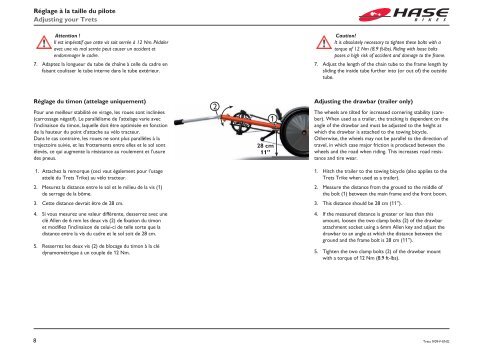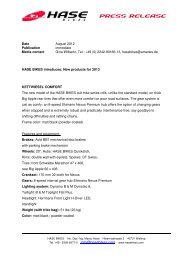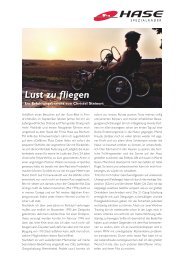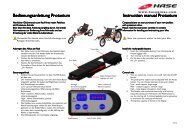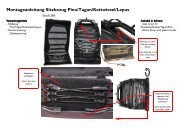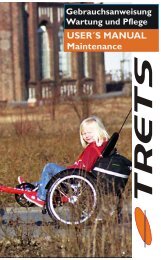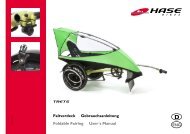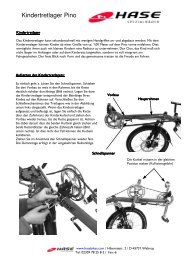Trets Mode d'emploi, version 9-09 F-ENG - Hase Bikes
Trets Mode d'emploi, version 9-09 F-ENG - Hase Bikes
Trets Mode d'emploi, version 9-09 F-ENG - Hase Bikes
You also want an ePaper? Increase the reach of your titles
YUMPU automatically turns print PDFs into web optimized ePapers that Google loves.
Réglage à la taille du pilote<br />
Adjusting your <strong>Trets</strong><br />
8<br />
Attention !<br />
Il est impératif que cette vis soit serrée à 12 Nm. Pédaler<br />
avec une vis mal serrée peut causer un accident et<br />
endommager le cadre.<br />
7. Adaptez la longueur du tube de chaîne à celle du cadre en<br />
faisant coulisser le tube interne dans le tube extérieur.<br />
Réglage du timon (attelage uniquement)<br />
Pour une meilleur stabilité en virage, les roues sont inclinées<br />
(carrossage négatif). Le parallélisme de l’attelage varie avec<br />
l’inclinaison du timon, laquelle doit être optimisée en fonction<br />
de la hauteur du point d‘attache au vélo tracteur.<br />
Dans le cas contraire, les roues ne sont plus parallèles à la<br />
trajectoire suivie, et les frottements entre elles et le sol sont<br />
élevés, ce qui augmente la résistance au roulement et l’usure<br />
des pneus.<br />
. Attachez la remorque (ceci vaut également pour l’usage<br />
attelé du <strong>Trets</strong> Trike) au vélo tracteur.<br />
2. Mesurez la distance entre le sol et le milieu de la vis ( )<br />
de serrage de la bôme.<br />
3. Cette distance devrait être de 28 cm.<br />
4. Si vous mesurez une valeur différente, desserrez avec une<br />
clé Allen de 6 mm les deux vis (2) de fixation du timon<br />
et modifiez l’inclinaison de celui-ci de telle sorte que la<br />
distance entre la vis du cadre et le sol soit de 28 cm.<br />
5. Resserrez les deux vis (2) de blocage du timon à la clé<br />
dynamométrique à un couple de 2 Nm.<br />
2<br />
28 cm<br />
11”<br />
Caution!<br />
It is absolutely necessary to tighten these bolts with a<br />
torque of 12 Nm (8.9 ft-lbs). Riding with loose bolts<br />
poses a high risk of accident and damage to the frame.<br />
7. Adjust the length of the chain tube to the frame length by<br />
sliding the inside tube further into (or out of) the outside<br />
tube.<br />
Adjusting the drawbar (trailer only)<br />
The wheels are tilted for increased cornering stability (camber).<br />
When used as a trailer, the tracking is dependent on the<br />
angle of the drawbar and must be adjusted to the height at<br />
which the drawbar is attached to the towing bicycle.<br />
Otherwise, the wheels may not be parallel to the direction of<br />
travel, in which case major friction is produced between the<br />
wheels and the road when riding. This increases road resistance<br />
and tire wear.<br />
. Hitch the trailer to the towing bicycle (also applies to the<br />
<strong>Trets</strong> Trike when used as a trailer).<br />
2. Measure the distance from the ground to the middle of<br />
the bolt ( ) between the main frame and the front boom.<br />
3. This distance should be 28 cm ( ”).<br />
4. If the measured distance is greater or less than this<br />
amount, loosen the two clamp bolts (2) of the drawbar<br />
attachment socket using a 6mm Allen key and adjust the<br />
drawbar to an angle at which the distance between the<br />
ground and the frame bolt is 28 cm ( ”).<br />
5. Tighten the two clamp bolts (2) of the drawbar mount<br />
with a torque of 2 Nm (8.9 ft-lbs).<br />
<strong>Trets</strong> 9/<strong>09</strong>-F-<strong>ENG</strong>


